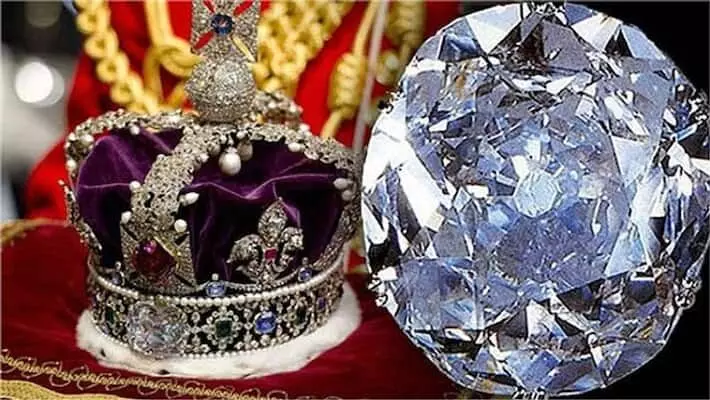Is the Kohinoor really cursed?
Today, the Kohinoor is a part of the Crown Jewels on display at the Tower of London as a celebrity diamond.
By Salma Ahmed Farooqui
Hyderabad: The Kohinoor, the famed diamond, believed to have been found in the Kollur mines of the Deccan, has never lost its intriguing appeal for centuries. It is again in the news as King Charles III’s coronation draws near. This precious rock passed through the hands of the Mughal princes, Persian and Afghan rulers and the Maharajas of Punjab, from where it boarded for an international destination to London and has remained there ever since. Today, the Kohinoor is a part of the Crown Jewels on display at the Tower of London as a celebrity diamond.
A story goes that Nader Shah, the Persian king of the Afsharid dynasty, came to know that the Mughal emperor, Muhammad Shah, carried a large diamond in his turban. So, when he invaded the Mughal capital, he extended a hand of friendship to the Mughal ruler by inviting him for a feast. He asked the latter to ratify their friendship by exchanging turbans, a friendly tradition in those times. After getting the Mughal ruler’s turban, Nader Shah, in seclusion, slowly opened it and found a big diamond that made him shout with joy, saying ‘Kohinoor’ literally meaning a mountain of light. That’s how the diamond received its name.
Soon afterwards, the myths and history of the omens associated with the Kohinoor started to gain currency. As Royina Grewal, in her book ‘In the Shadow of the Taj: A Portrait of Agra’ says, Nader Shah was assassinated; so were his sons Adil Shah and Ibrahim in a gory fashion. Shahrukh, his grandson, was then forced to hand over the Kohinoor to Ahmad Shah of Afghanistan. After getting the Kohinoor in his hands, Ahmad Shah died and a civil war started between his 23 sons, until two of his surviving sons fled to Punjab with the diamond.
Keeping himself away from the story of the misfortune, Maharaja Ranjit Singh kept the Kohinoor in his custody. History shows that after Ranjit Singh’s death, a competition for the throne ensued and finally, Punjab was annexed by the British in 1849. The property of the state was confiscated by the East India Company. It was stipulated that the Kohinoor would be presented to the Queen of England as a symbol of the conquest of India. Consequently, Lord Dalhousie sent it to England in 1850.
After the Great Exhibition of 1851, where the Kohinoor was put up on display, Voorsanger, a skilled diamond cutter from Messers Coster’s factory in Amsterdam, working on reducing the weight of this stone from 186 1/16 to 106 1/16 carats. Queen Victoria first wore the gem in her crown and then had it set in a brooch. The legend that only a woman could have worn the Kohinoor without ill luck befalling her, might seemingly turn true. The Queen was declared the Kaiser-i-Hind or the Empress of India. The next Queen, Alexandra, wife of King Edward VII, Victoria’s oldest son, was in line to wear the diamond set in the Queen Consort’s crown at her coronation in 1902. The royalty, by then, believed in the superstition of the gem’s bad omen.
Finding the crown too grand, Princess Mary, who was set to marry King George V, grandson of Victoria, in 1911, settled for a simpler design of the crown. Hence, the Kohinoor was transferred to her crown. Even after toning it down, like Queen Victoria and Queen Alexandra, Queen Mary too chose to keep the Kohinoor as the central point. The stone was encrusted in its current place in 1937 at the front of the crown of Queen Elizabeth I for her coronation as Queen Consort of King George VI and others of Elizabeth II. Queen Elizabeth I was also known as Queen Mother. When she died in 2002, her oldest daughter Princess Elizabeth II wore the platinum crown during her reign as the monarch of England. The Queen Mother’s crown, housed in the Tower of London, was taken out to rest on the coffins of Queen Elizabeth I and II.
There is a new twist now that the new Queen Consort Camilla to King Charles III, will not wear the controversial Kohinoor diamond in her crown. According to reports, the crown will be set without the precious stone for the coronation. The contested treasure has made critics again open up the debate about an imperialistic Britain colonising India and plundering its wealth. This perhaps could be why the new Queen consort does not want to open up old wounds of which the Kohinoor continues to be the symbol. Queen Camilla is surely safe wearing it in her crown, if she decides to, as the curse of the Kohinoor, was known to bring bad luck to a male ruler who owned it and has never brought bad luck to a woman.
Professor Salma Ahmed Farooqui is a reputed historian of the country and Professor at the H.K.Sherwani Centre for Deccan Studies at the Maulana Azad National Urdu University, Hyderabad.